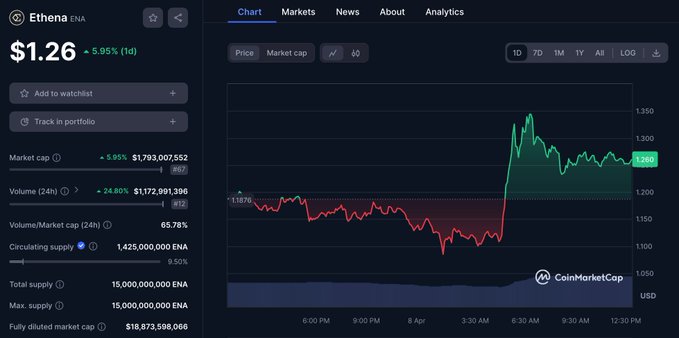Ethena’s governance token, ENA, soared by an impressive 20% to hit a new all-time high of $1.35 on Monday, spurred by a significant announcement from Ethena Labs. The announcement detailed a rewarding opportunity for ENA holders, leading to increased market demand and a surge in token value from its previous mark of $1.10.
The surge was triggered by Ethena Labs’ revelation that ENA holders could now earn additional points, potentially leading to a more substantial airdrop. This development comes on the heels of a recent airdrop that distributed 750 million tokens, equivalent to 5% of the total supply, to early platform adopters.

Users who commit at least 50% of their total USDe holdings in ENA are set to benefit from enhanced rewards, including a notable 50% increase and the highest rewards per day across all pools. The program mandates a minimum seven-day lock period for ENA tokens, with locked tokens earning rewards at an accelerated rate of 30 times the norm.
Today we introduce $ENA into Season 2 in order to more closely align the growth in USDe with $ENA
Users who lock $ENA at a minimum of 50% of their total USDe holdings per wallet will receive
i) 50% increase in their rewards
ii) the highest number of rewards per day of any pool pic.twitter.com/zxVmpGZSN6— Ethena Labs (@ethena_labs) April 8, 2024
Following this surge, Ethena’s market capitalization has doubled to an impressive $1.8 billion in just one week, underscoring growing investor interest in both the platform and its native tokens.
Ethena’s points program, initiated in mid-February, recently expanded its scope to incorporate bitcoin as collateral, marking the inception of its second season, dubbed the “Sats Campaign.” Scheduled to conclude on Sept. 2, or earlier if the total value locked in USDe reaches $5 billion, the campaign has seen significant growth, with USDe TVL currently standing at $2.1 billion, a 36% increase in the past seven days.
To capitalize on the rewards boost, users must lock a substantial portion of ENA relative to their USDe balance across various platforms. Ethena has specified that only circulating ENA acquired through the initial airdrop or purchased on the open market is eligible for locking, excluding team and investor allocations tied to vesting schedules.



